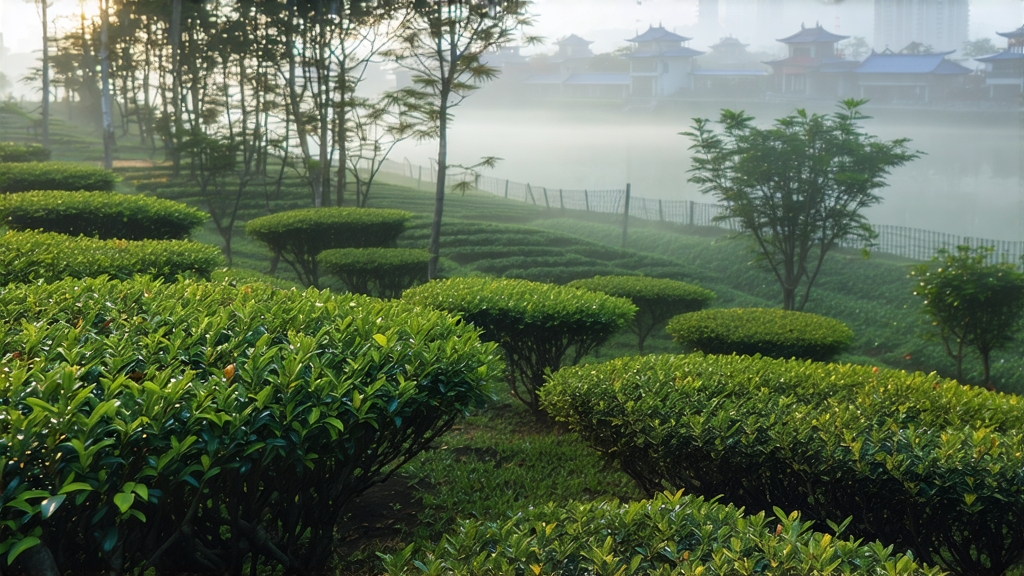
Tucked between the mist-laden loess hills of Dongting East Mountain and the shimmering waters of Lake Tai, Biluochun—literally “Green Snail Spring”—has been seducing tea lovers since the late Tang dynasty. Legend claims a tea picker ran out of basket space and tucked fresh shoots inside her bodice; the warmth of her skin released an intoxicating aroma that startled passing monks, who asked the name of the “scaringly fragrant” tea. By the Kangxi era (1661-1722) the emperor, touring the Jiangnan region, found the name “Scary Fragrance” too vulgar and rechristened it Biluochun for its jade spirals resembling tiny snails and its spring harvest window.
Botanically, Biluochun belongs to the small-leaf Camellia sinensis var. sinensis. Within the narrow microclimate of Dongting’s peninsula, two clonal selections dominate: the traditional “Dongting Original” (fruit-tree intercrop) and the later-selected “Wuzhong Early Sprout,” which germinates seven to ten days ahead, extending the picking season. Farmers further divide the harvest into five lunar windows—Toucai (first sprout), Yacai (second), Chunmei (third), Chunwei (fourth) and Guyu (grain rain). Only the first two qualify for the top-grade “Special Supreme,” demanding one unopened bud plus the adjacent leaf, no longer than 2.5 cm and plucked before 10 a.m. while the lake mist still lingers.
The craft has remained almost unchanged for three centuries. After a brief 2–3 hour withering on bamboo trays, the leaves are “killed-green” in a cast-iron pan pre-heated to 180 °C. A single craftsman handles 250 g per batch, tossing, pressing and rolling the leaves for precisely 3.5 minutes while the temperature drops to 80 °C. The critical spiral is formed during the subsequent “rub-fry” stage: palms trace counter-clockwise circles against the pan, coaxing the leaf into a tight curl and locking in the amino-rich sap. Final moisture is reduced to 6–7 % over a gentle 60 °C heat, after which the tea rests in linen bags for 24 hours so the remaining lake-mist moisture migrates outward, stabilizing the aroma.
Brewing Biluochun is an exercise in restraint. Its downy tips release flavor so readily that professionals recommend 3 g per 150 ml, 75 °C water and a 30-second first infusion in a tall glass. The leaves sink in cascades, unfurling like miniature green fireworks and exuding notes of white peach, baby spinach and a faint marine salinity reminiscent of lake breeze. Second infusion at 40 seconds amplifies sweetness while muting grassiness; a third at one minute often surprises with a custard-like finish. Avoid lid-covered vessels—Biluochun’s volatile geraniol and linalool compounds are heat-sensitive and can flatten under steam.
To evaluate a sample, first examine the dry shape: top grades show uniform snail curls, silvery tips and absence of stem fragments. In the aroma cup, shake the cooled leaves; a high-pitched nectarine and freesia bouquet indicates proper low-temperature finishing. On the palate, look for “three greens and one gold”: green dry leaf, green liquor, green infused leaf, and a gold ring of amino acids that clings to the cup’s inner rim when the tea is slightly cooled. A tell-tale sign of authenticity is the lingering “lake sweetness,” a cool, glyceric sensation at the back of the throat that arrives 30 seconds after swallowing—impossible to replicate outside the Taihu microclimate.
Unlike many green teas that fade within six months, well-stored Biluochun keeps its vivacity for twelve. The key is double-layer protection: an inner pouch of food-grade aluminum foil heat-sealed against oxygen, then a waxed kraft tin stored at 0–5 °C and 45 % relative humidity. Connoisseurs often hold back 100 g of pre-Qingming lots, revisiting them at the autumn moon festival; the slight oxidation that occurs lends a magnolia nuance absent in spring.
Modern science has validated what Kangxi intuited. Biluochun’s unique terroir—granite-derived sandy loam, 78 % annual humidity and refracted lake light—yields leaves with 4.2 % theanine and a catechin-to-theanine ratio below